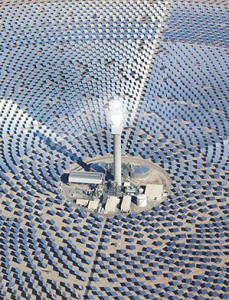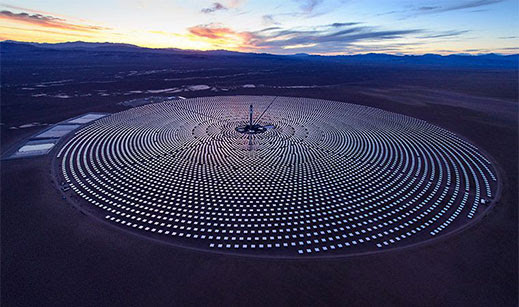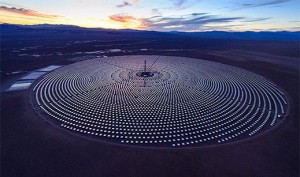MIT Technology Review
By Richard Martin
A new plant opening in Morocco signals the technology’s direction.
Solar thermal plants like this one, at Crescent Dunes near Tonopah, Nevada, may be better suited for overseas markets rather than the United States.
Next month, in the Moroccan desert near the city of Ouarzazate, a complex of 500,000 parabolic mirrors will begin reflecting the sun’s rays onto a fluid that runs through steel pipes above them, creating steam and driving turbines to generate electricity.
Called Noor 1, this system, capable of generating up to 160 megawatts of power, will form the first of four solar thermal plants that will eventually have a combined capacity of 580 megawatts. Scheduled for completion by 2020, Ouarzazate will be the largest solar thermal plant in the world.
Recently, however, many observers have begun to question the future of the technology. In the United States, at least, solar thermal has been undercut by cheap natural gas and by the plummeting cost of power from solar photovoltaic plants, which use conventional solar panels. According to the U.S. Energy Information Administration, electricity generated at a solar thermal plant coming online in 2020 will cost 24 cents per kilowatt-hour, nearly twice the cost of solar PV. While a few plants, including the Ivanpah station in the Mojave Desert, have come online in recent years, there are no new solar thermal plants planned in the U.S.
In 2013, BrightSource, the developer of the Ivanpah project, canceled two multibillion-dollar solar thermal plants under development in California. And several projects, such as the high-profile Blythe plant in Riverside, California, were originally envisioned as solar thermal plants but have been converted to photovoltaics. As a result, U.S. solar thermal developers, such as BrightSource Energy (builder of the Ivanpah plant) and Solar Reserve, which built the Crescent Dunes plant, near Tonopah, Nevada, have been forced to look overseas for future growth.
“It’s tough to compete against $3 [per million BTU] natural gas,” says Kevin Smith, CEO of Solar Reserve, a U.S. company that plans to build solar thermal plants in South Africa, Chile, and the Middle East.

The energy storage system at Crescent Dunes can supply 110 megawatts of capacity for 10 hours after the sun goes down.
What’s more, solar thermal only works in direct sunlight on large swaths of land, which limits the plants to desert regions such as the American Southwest and the Middle East (see “Abu Dhabi Plugs in Giant Concentrating Solar Plant”).
These competitive pressures have split the sector—a stagnant market in the U.S. for solar thermal technology, versus burgeoning opportunities overseas, particularly in the Middle East and Africa. The U.S. Energy Information Administration forecasts that the total capacity of solar thermal in the United States will remain essentially flat through 2040. Worldwide, on the other hand, the technology is expected to spread: according to the International Energy Agency, solar thermal plants will account for 11 percent of global electricity generation by 2050, up from less than 1 percent today. Among the desert countries with ambitious solar thermal plans are the United Arab Emirates and Saudi Arabia.
BrightSource, meanwhile, has no new plants underway in the U.S. but is building a new plant at Ashalim, Israel, and has formed a joint venture with Shanghai Electric Group to build utility-scale solar thermal plants in China. And Solar Reserve has lined up financing support from the Overseas Private Investment Corporation to build the 100-megawatt Redstone Concentrating Solar Power Project at Northern Cape, South Africa. These companies are also eyeing non-electricity-generating applications for the technology, supplying heat for industrial processes such as desalination of ocean water.
Executives at solar thermal developers and analysts with industry groups like the Electric Power Research Institute foresee a comeback for the technology domestically as the cost of building plants falls and the need for more flexible and reliable resources to help integrate wind and solar PV becomes more acute. While there are no technological breakthroughs on the horizon that will abruptly slash the cost of power from solar thermal plants, improved designs, volume manufacturing, and the use of streamlined technologies such as wireless controls to adjust the orientation of the mirrors should all combine to lower costs. Better components and improvements in the heat transfer fluid (such as the use of supercritical carbon dioxide) could reduce those costs further.
More importantly, the value of solar thermal plus energy storage should become more apparent as more renewable generation capacity is integrated into the grid (see “Cheap Solar Power—at Night”). The Crescent Dunes plant, for instance, can continue operating at its 110-megawatt capacity for 10 hours after the sun goes down. That could reduce the need for fossil fuel-powered backup plants that supply power when the sun’s not shining. And by increasing the plant’s total output, it decreases the overall cost of producing power. A report published earlier this year by the MIT Energy Initiative calculated that adding storage to a solar thermal plant reduces the cost of electricity from the plant by 11 percent.
That could make solar thermal competitive in the U.S.—but first it must prove to be economical elsewhere.








